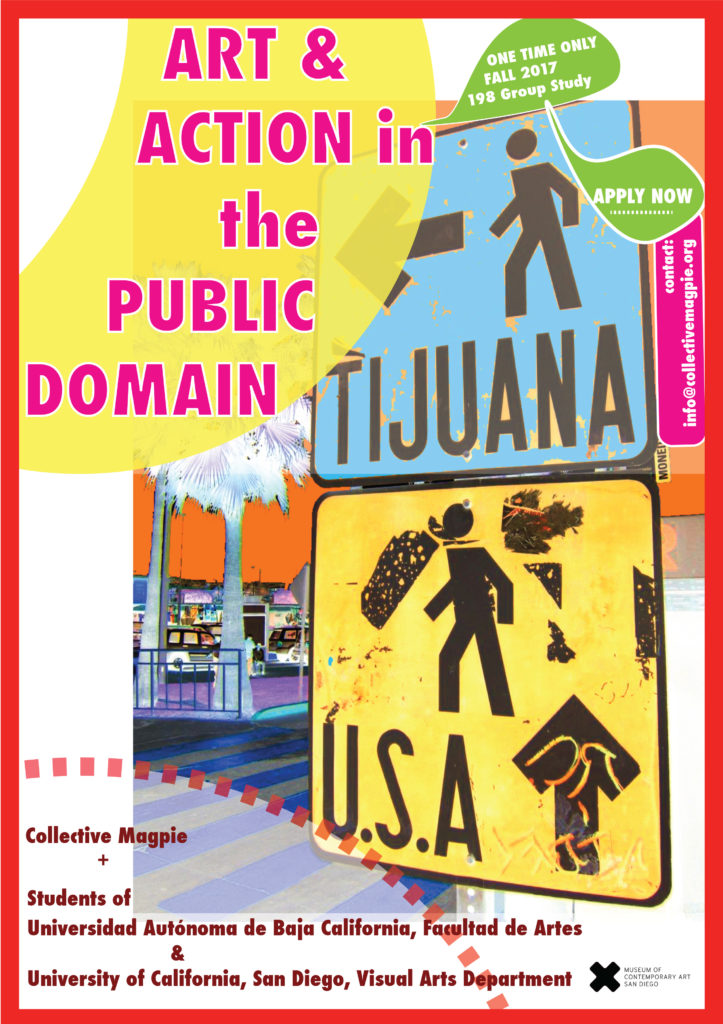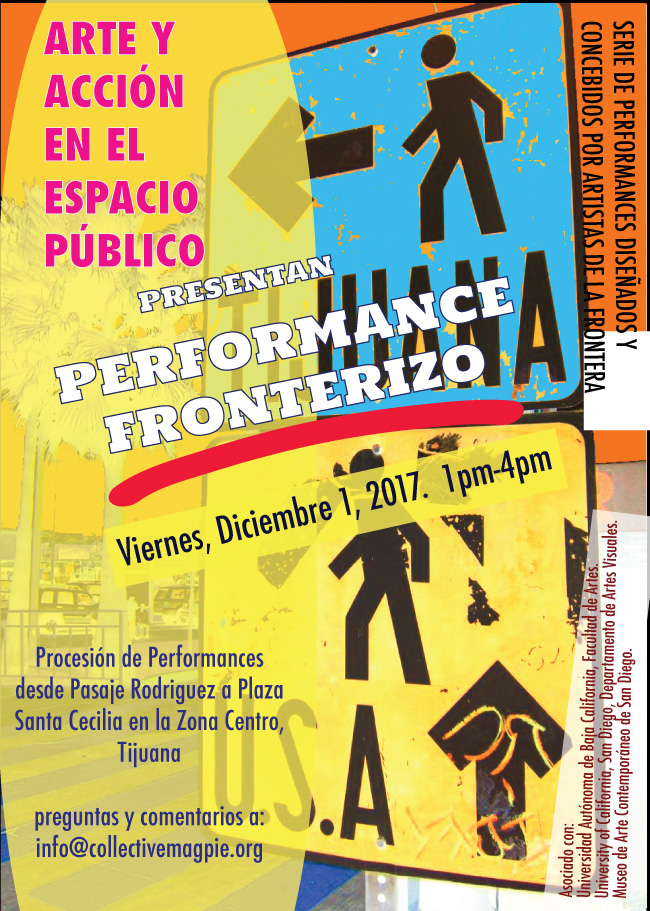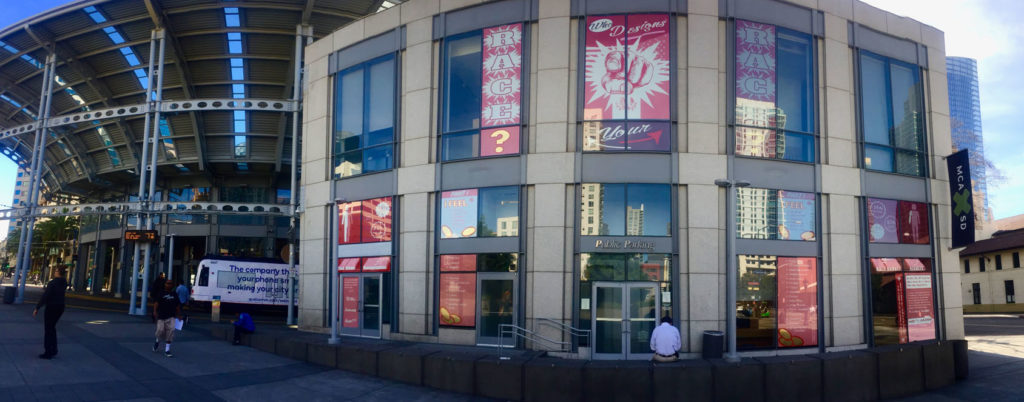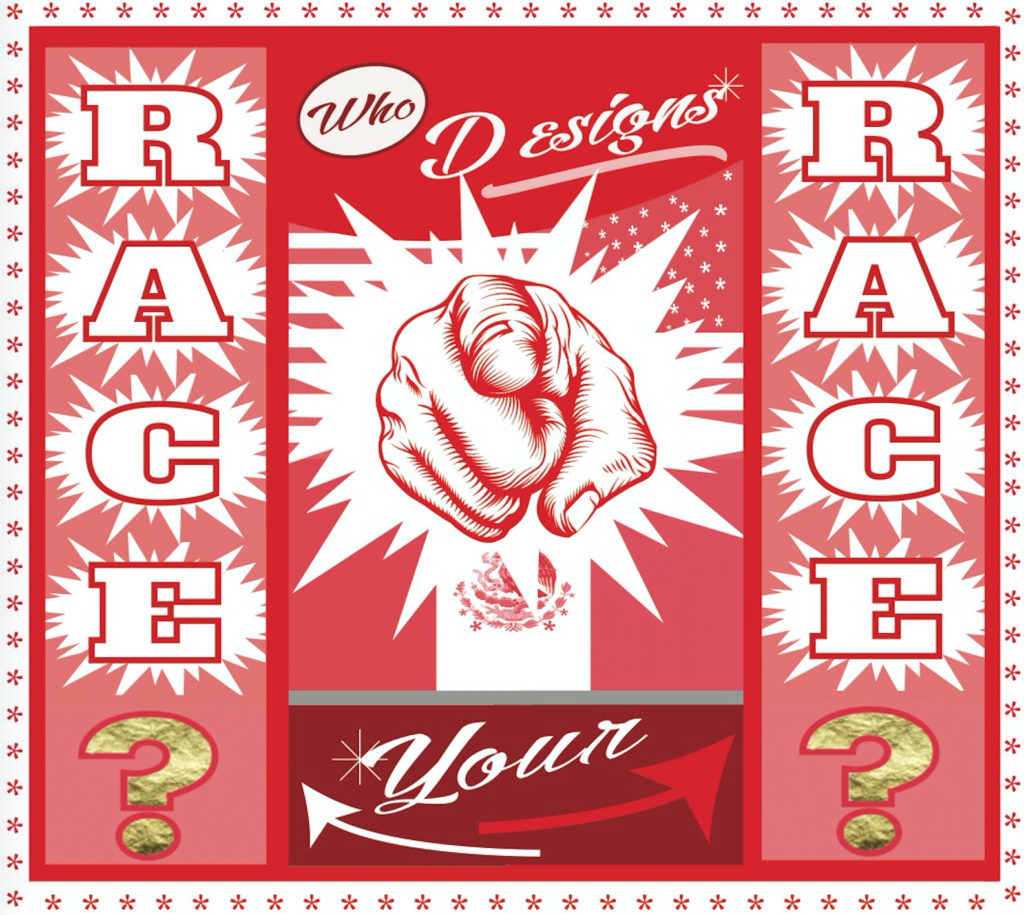Collective Magpie explores the concepts of race and identity in cultural borderlands
“Collective Magpie = Tae Hwang & MR Barnadas + Participants”
So says the equation at the top of the Collective Magpie website, and it is meant to underscore the fact that they function as a “collective” outside of just themselves as the leading artists. All of the work of this nomadic collective is in the public domain, created in collaboration with community participants.
Hwang and Barnadas met in 1996 as undergrads at the School of the Art Institute of Chicago where both studied painting (Barnadas also has a background working with bronze sculpture and electronics). They have been working together pretty much ever since, starting with a shared position, and salary, in their student union art gallery and going on to the University of California, San Diego where they were admitted as a collective and earned a shared degree—an effort designed as a type of institutional critique, and a first for the university.
“We’ve been working together for 22 years now, but we didn’t decide we were going to work together for this long. We had no intention of working together!” Hwang laughs.
She explains that when they started working together, they didn’t have a sense of what a “collaborative practice” was or what that even meant, but their work together naturally evolved over time to the collective that it is today, defining itself along the way.
Eventually they formalized their collaborations as Collective Magpie in 2008, a name intentionally chosen to give their participants ownership in the work they create.
“Our practice is this shared engagement, negotiating between different places, people, and questions we have,” says Barnadas. “It wasn’t the sort of thing where we sat down and wrote a manifesto and have our social intention described under the name. Initially it came from a place of wanting to recognize in our name that our intention was to work together and with large groups of people collectively, and that’s why we started using a ‘collective’ name.”
She goes on to explain that much of the intention working in this collaborative way came out of response to their formal arts education training.
“The notion of ‘community arts’ has now been elevated in the art world as something worthy of examination, but when we were in school that wasn’t the case,” she says. “It was a single track: gallery-bound if you were lucky. Working with the community was our response to that.”
Their first public work under the Collective Magpie umbrella was at the Bata Shoe Museum in Toronto. They had 20,000 people show up in one night to create a collective painting—people of all ages and ethnicities, all participating in a giant paint-by-numbers mural. This sparked their passion and drive to do more such projects, projects that are now referred to commonly as “social practice.”
“’Social practice’ has become this genre and it describes what we had been doing, but at the same time there is a struggle to have this legitimacy in the work—like, maybe it’s ‘social practice,’ or maybe it’s just ‘community art.’ We want to use this name to legitimize our work and elevate this shared ownership,” Barnadas explains.

While earning their shared degree in San Diego, they began to think about the context of borderlands. Living in the San Diego/Tijuana region, the most frequently crossed border in the world, their work began responding to what it means to live in binational and transnational zones.
They have spent six years doing work in this region, and all of the projects they have facilitated there are in response to the place. Even in a world before President Trump, when Collective Magpie first started producing work there, immigration and border security were still very much issues, and for many people living in this region, the border is a palpable, looming presence.
“It’s an odd space where a large segment of the population’s whole life is majorly influenced by the border, and then there’s another whole section of the population who never consider it,” says Barnadas. Just in collaborations with the New Children’s Museum in San Diego, they observed a stark disconnect in the lived experiences of the children visiting. “Kids that go to this museum are a mix of those who are bussed in from Mexico or the Mexican-influenced areas of San Diego, as well as kids from affluent neighborhoods who don’t even know that another country is so close to them.”
They’ve done several partnerships exploring the idea of what it means to be living in the borderlands in collaboration with institutions from both sides of the border, including the New Children’s Museum; the Museum of Contemporary Art San Diego; El Trompo Museo Interactivo Tijuana; the University of California, San Diego; Southwestern College, Universidad Autónoma de Baja California, Tijuana; and others.
They chose to work on “binational” projects that involve a high degree of exchange between institutions and participants from both the San Diego and the Tijuana sides of the border. Projects have included a semester-long transnational seminar for course credit with students from three schools on both sides of the border and involving multiple site visits to both major cities.
“They came together as one class,” Hwang says. “Everyone was asked to go back and forth across the border a lot. Southwestern College has the largest transnational student body and their main campus is in Chula Vista right by the border so they were already crossing back and forth a lot anyway, whereas with UCSD in La Jolla the students had to sign a waiver that the minute they crossed the border UCSD was no longer responsible for them, so there was already this tension from San Diego.”
They held this transnational seminar twice, first tackling the notion of border to examine how people understand the word or notion of “border.” Participants conducted self- and peer interviews about the border, which were published and distributed in San Diego. And not all of the interviews dealt specifically with the San Diego/Tijuana border: This was a transnational project, with students that also came from other countries like China and Singapore who had their own unique perspectives on what a “border” is and how it is defined. They published these interviews in the 500-page 82 Border Conversations available on their website.
The second seminar was explicitly political and specifically targeted the U.S.-Mexico border. At this point Trump was in office and anti-immigrant, anti-Mexican rhetoric was reaching a fever pitch. UCSD was having issues with anti-Mexican hate speech on campus, and twice there were incidents involving border patrol officers coming onto campus and asking people for documentation. Mexican students were made to feel unwelcome, so the seminar “Art & Action in the Public Domain” directly engaged the politics of the U.S.-Mexico border wall, allowing students to engage with that topic in whatever way they wanted to.

Aided by techniques from Theatre of the Oppressed, one class session involved creating street theatre pieces that was performed for both San Diego and Tijuana audiences.
“In our studio classes we were trying to answer some of these questions we ourselves don’t know the answers to, and what’s a better way to do that than to just go out into the public and ask questions?” says Hwang. “We have no street theatre background, so it was interesting!”
A significant element of all of their seminar classes, including others that were domestic, involved conducting a “race survey.” They developed this in response to a demographic survey conducted by the Museum of Contemporary Art San Diego: After touring a new exhibit meant to address racial barriers and tensions, the seminar students were asked to fill out a survey that included their name and race.
“We check that box all the time and we don’t even think about checking the box,” says Hwang. “But in Mexico, no one asks what race you are, so Mexican students didn’t understand it. To them it felt like the museum wanted to define them through race. From that we had a lot of discussions and we decided to make a race survey through artwork.”
The survey they created was designed to get people to think about ‘race’ as a messy space. Hwang and Barnadas distributed these surveys in front of the museum in downtown San Diego, right by a border-crossing trolley stop. Their survey was a combination of questions from the most recent United States and Mexico censuses.
“In Mexico they don’t have these categories of race or ethnicity,” Hwang explains. “Their census is economic-driven: ‘What kind of plumbing do you have in your house? How many light bulbs do you have in your house?’ [These questions are socioeconomic status indicators in Mexico, but] most Americans wouldn’t even know the answers to those questions.”
They also included the kinds of questions a person might have to answer in a self-survey taken inside a therapist’s office, but made them race-subjective. So, instead of, “Do you feel depressed? How often? All the time? Some of the time? None of the time?” the question would be, “Do you feel Black? How often? All/some/none of the time? When and where do you feel Black?”

In the end they collected 100 surveys, then displayed the results on the museum’s façade alongside the City of San Diego’s published racial categories based on the census information.
“What we hope to do as artists is provoke a question,” says Hwang. “We certainly don’t have the solutions of how to solve a race war. Our intention isn’t to create a survey that would cure any kind of race issues, but just to have people think about these issues. If you live in Mexico people might call you a blonde, basically something that would be considered ‘white,’ but when they come into the U.S. they’re clearly not blonde anymore—they’re ‘Mexican.'”
Barnadas adds, “Especially when the museum was taking demographic information, we wanted to show how complicated it is to take demographic information for two very different cultural contexts, and how the experience of race changes at the point of crossing the border. Even within our own student population, some are white when they get up in the morning but brown when they go to class in San Diego by virtue of their nationality. What does that mean to be ‘white’ again when they go back home at the end of the day? We’re engaging with racial confusion: What does it mean if there is no visibility as to how race is subjective?”

After spending the last six years deeply embedded in explorations of racial lines and border identities in the San Diego/Tijuana region, Collective Magpie is now going to focus on an entirely different city: Baltimore.
“After having spent a lot of time thinking about what it means to be on an international cultural border, what’s interesting about Baltimore to us is that it is the northernmost Southern city and the southernmost Northern city,” says Barnadas. “There is a range of cultural borders that manifest very differently there.”
They will continue to work in San Diego as well, and currently have a public art project in the early stages of development.
While the next phase of their work will take them to a city that, while not on an international border, is very much on a cultural one, the underlying themes and concerns over immigration, displacement, diaspora, and xenophobia will always be a part of their work in some way. Both are immigrants to the United States, and while their history and relationship to immigration is very different, their projects come from this “shared psychic space” of what it mans to be an immigrant.
“Even in projects not directly engaging in activism, that is still at the core of our headspace and sensibility,” Barnadas says.

(1) How do you like to collaborate?
Barnadas: Our relationship is one. It’s a practice in a marriage that’s not a marriage. We’ve lived together, talked together, work together. It’s hard to understand where that collaboration begins and ends. And then we also collaborate with others—architects, engineers, the community.
Hwang: Collaboration is our nature at this point. For all of our projects we collaborate with other people and then with each other. Just thinking about the nature of living on the planet: It’s all about collaborating.
Barnadas: There are many levels and layers.
(2) How do you a start a project?
Hwang: We start some because we were given the opportunity because someone approached us or we approached them. It varies with each project. Sometimes we have a commission, or we look for funding.
Barnadas: Sometimes we approach others. A lot of it is relationship development. From there we’re often invited to things. When it comes down to art making, we think about those contexts. A lot of times we think about something that needs to be rendered visible that isn’t seen so much. It’s something we need to show.
Hwang: When we think about starting a project, it’s clearly not about a dream project. The biggest question is always budget and labor.
Barnadas: That’s a logistical response. As artists, in terms of funding, we make very little, but the one power we have is to render things visible when we’re working in the public domain. That’s something we take very seriously when we’re working with groups of people. We want to be careful; we don’t want to determine how people should look at the picture or claim to have some sort of solution to the thing, but we are aware that we can make things seen and that’s the elephant in the room when we’re considering projects.
Hwang: We do try to optimize ideas with a given limitation. We try to take advantage of the resources available.
(3) How do you talk about your value?
Hwang: The value of art and education is completely lacking in this country. If we as artists can make the value of art more visible and share that it would be really good for the country. Humanities and liberal arts are so marginalized and devalued. Artists have the responsibility to take that challenge on and try to make that happen in whatever way they can. It’s hard to communicate with people who don’t see a value in art.
Also we’ve been working from an education platform for many years, not only college students but adults and children too. In the past few years we’ve been working with [specific] colleges, and just the lack of understanding of what art is even in higher education is appalling. When we were in [UGSC] there was a constant marginalization of humanities. I feel like what’s happening in this country with science and technology proscribed all the perceived value, and also in the numbers: What they get in funding versus what the arts get. But art also has the highest cultural capital. There are paintings that sell at auction for millions of dollars, so in some ways it’s highly overvalued and in others it’s not valued at all.
Barnadas: Within the notion of “value” that shaped our practice, in many ways by sharing a portion of the authorship with shifting groups of people that we identify generally as ‘the public,’ we can’t sell our work by design. It is something that is meant to be in the public domain from the inception. These projects are meant to have a value system that doesn’t correlate with the art market or dollar exchange.
Hwang [laughs]: It’s a bad business model.
Barnadas: It’s definitely not a business model but for us, but this was a way of taking that off the table entirely. Of course money is involved, but we don’t want that to be the focus.
(4) How do you define success?
Hwang: At the moment when we conduct our workshops or events or projects, it’s the level of engagement that makes me feel like this could have been kind of an interesting thing that we’ve done. The first thing we did was giant paint-by-numbers at the Bata Shoe Museum and thousands of people came out for this, ages 5 to 70, 80 years old. It was a very simple concept: Grab a brush and paint. The comments we got from them was very interesting. Even with the race survey, there were comments that were very positive and very negative. For me the least successful project is if the audience is indifferent to the work. However it affects them in some way, I feel like it was successful.
We also try not to think in those terms. With each project we take, we look at it as it is what it was and try to look at what interesting things came out of it and how we can learn from the experience. We just have to keep moving forward.
Barnadas: Once we have a sense of where something is being produced and what we’re trying to tackle in an art production, we’re thinking of what we’re making as a type of infrastructure put out with a group of people to engage with it. Maybe we’re creating an instrument but we have yet to determine how it’s going to be played. The work is being produced with participants: We give them tools but don’t know how it’s going to be put together. With the hot air balloons in Mexico City, they have to be constructed in a very specific way, but what is it going to mean for Mexican veterans to produce something that’s going to go where they can’t—like to go back home to the country they fought for? We want this infrastructure we’re making to be used and to be meaningful to the people who are using it. The primary audience is the participants, but also part of it is the people who will see it; that’s the secondary audience. There are narratives being constructed that we hope are contributing to pictures of people and place, offering a nuanced construction of the place and time they occurred.
(5) How do you fund your work?
Hwang: Ninety percent of our work is self-funded. In looking at our whole body of work, some funding comes from private and some from public sources, but we have to have jobs that pay and we have to take vacation time so that we can do our work.
We have really bad paying jobs. We have to work full time to fund our work. Also, trying to write a grant is a full-time job and it’s very competitive, especially when all the arts funding has been cut and all these things are extremely difficult to get. I am so against the rhetoric in the media about how artists don’t have to get paid as much as they do because they love what they do: That’s completely bogus, this idea that if I love what I do then I should do it for free. So we’re constantly being undervalued with our labor and everything else.
Barnadas: We work with places like museums and cultural centers, and we are able to be successful in grant writing and obtaining funds to support our practice and projects. Lots of people participate and our projects are highly visible. We create cross-institutional connections that multiple institutions have had a hard time doing on their own, so we’ve acted as a bridge. Oftentimes it appears we’re well-funded, and we have spent portions of time being completely funded but not to the point of being able to live without having outside jobs.
At the end of the day we’re living in poverty. The reality is we are in a very financially tenuous position; we’re not financially stable, we’re not independently wealthy, and we’re not fully supported by an institution on tenor-track position.
Hwang: You hear about a lot of people getting these big funds more than about people not getting really big funds. It’s this horrifying reality. Nowadays when I hear someone talking about getting a degree in art I’m like “No, don’t do it! You come out of school with no skills you can survive on!”
Barnadas: Tom Finkelpearl, commissioner of the New York City Department of Cultural Affairs, years ago at an arts college convocation decided to ask questions to the educators that were there. One of the other things he brought up was, “Every year we have hundreds of thousands of people graduating with art degrees and thousands of dollars in debt without a realistic return to pay it off. What as educators are you doing about that?” As an educator I don’t want to be part of a program that supports something people are paying for and can’t pay back.
